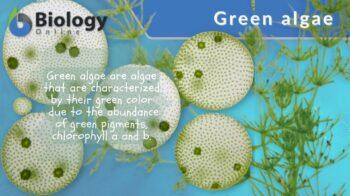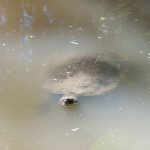
Green algae
n., singularl: green alga
[ɡɹin ˈæl.ɡə]
Definition: algae belonging to Chlorophyta and Charophyta
Table of Contents
Green Algae Definition
Green algae (singular: green alga) are photosynthetic algae that are characterized by having chlorophylls a and b as the predominant pigments, thus rendering them green in color. They store food as starch within plastids. They include the Chlorophyta (chlorophytes) and the Streptophyta, particularly the Charophytes.
Watch this vid about green algae:
Classification and Taxonomy
Algae belong to a paraphyletic group that is distinguished from the other groups of organisms by being aquatic, photosynthetic, eukaryotic organisms. They include a wide range of organisms, i.e. from unicellular, to colonial, to multicellular forms. Generally, algae possess chlorophyll but lack true roots, stems, and leaves characteristic of the embryophytes. Algae can be further classified based on their predominant photosynthetic pigments. Green algae are a group of algae characterized by their greenish color as opposed to other groups of algae such as red algae (Rhodophyta), brown algae (e.g. Phaeophyta), golden algae (Chrysophyta), and blue-green algae (Cyanophyta). The greenish color and the photosynthetic capability of the green algae are associated with the abundance of chlorophylls a and b in their plastids. These pigments are in the same proportions the same way as those in vascular plants.
Sub-groups of green algae
Green algae include the chlorophytes and the charophytes. The charophytes are green algae mainly found in freshwater whereas the chlorophytes are those found mostly in marine water. There are also green algae that live in terrestrial habitats (e.g. soil, rocks, and trees).
The charophytes are more closely related to the embryophytes, i.e. the land plants that include the bryophytes and the tracheophytes (vascular plants). Unlike the chlorophytes, both charophytes and embryophytes possess enzymes such as class I aldolase, Cu/Zn superoxide dismutase, glycolate oxidase, and flagellar peroxidase. Furthermore, the charophytes, similar to embryophytes, use phragmoplasts during cell division. Thus, together with the embryophytes, the charophytes form the clade Streptophyta.
Table 1: Difference between Chlorophytes nd Charophytes | |
|---|---|
| Chlorophytes | Charophytes |
| Green algae | Green algae |
| Predominant pigments: Chlorophyll a and b | Predominant pigments: Chlorophyll a and b |
| Carbohydrate food reserve: starch | Carbohydrate food reserve: starch |
| Mostly marine | Mostly freshwater |
| Includes the core chlorophytes and prasinophytes | Where embryophytes (land plants) emerged |
| Examples: taxonomic classes such as Chlorophyceae, Ulvophycea (ulvophytes), Trebouxiophyceae, Chlorodendrophyceae, prasinophytes, etc.
| Examples: taxonomic classes such as Mesostigmatophyceae, Chlorokybophyceae, Klebsormidiophyceae, Charophyceae, Zygnematophyceae, Coleochaetophyceae
|
General Characteristics
Here are the general characteristics of green algae:
- Forms: Green algae have many forms: unicellular, multicellular, or colonial. Unicellular green algae are solitary, single-celled photosynthetic organisms (e.g. Micrasterias sp.). Multicellular algae are those that appear filamentous or forming leaf-like thallus (Ulva sp.). Some of them form colonies, such as Volvox species.
- Cell wall: The cell wall of a green algal cell is comprised chiefly of cellulose.
- Pigments: The chloroplast consists predominantly of green pigments, i.e. chlorophylls a and b. Other pigments present are the accessory pigments, beta-carotene, and xanthophylls. (1)
- Stored food: They store photosynthetic products in the form of starch.
- Motility: Some green algae are flagellated. The flagella are usually two to three in number, located apically or sub-apically. The flagella are used for cell movement.
- Reproduction and alternation of generations: Green algae may reproduce asexually or sexually.
- Asexual reproduction is done by means of spores.
- Sexual reproduction involves the exchange of nuclei via conjugation tubes. When the two gametes that fuse are identical, this form of sexual reproduction is referred to as isogamy. Conversely, when the two gametes in union are not identical (i.e. the smaller, motile gamete fuses with the larger non-motile gamete), this form of sexual reproduction is called oogamy.
- Some species may be typified into either haplobiontic or diplobiontic based on their life cycles. Haplobiontic green algae are those in which the gametophyte (haploid) generation is multicellular. As for the diplobiontic, both the haploid and diploid (sporophyte) phases are multicellular. They follow a life cycle called alternation of generations wherein the haploid phase and the diploid phase alternate.
Evolution and Phylogeny
Green algae are presumed to be the ancestral origin of land plants (Embryophyta). The endosymbiotic theory postulates that the green algae emerged from earlier eukaryotes that engulfed photosynthetic prokaryotes. The symbiosis between the two primitive life forms led to the fixed incorporation of the prokaryote inside the host cell and the eventual transformation of the former into an organelle, particularly the plastid. This event is presumed as well to have led to the rise of other clades of autotrophs, i.e. the red algae and the glaucophytes. (2) The green algae, in turn, evolved and are presumed to give rise to the embryophytes, particularly, via the Phylum Charophyta.
Biological Importance
Green algae are an important food source for aquatic organisms. They are an essential source of starch, which they produce via photosynthesis. Because of their photosynthetic activity, they are a vital source as well of atmospheric oxygen. They establish a symbiotic relationship with other organisms. For instance, they can be found to be closely associated with the ciliate Paramecium. The green algae Trebouxia spp. form lichens with fungi. Another is Chlorella species forming symbiosis with Hydra species.
Answer the quiz below to check what you have learned so far about green algae.
Further Reading
References
- Judd, W. S., Campbell, C. S., Kellogg, E. A., Stevens, P. F., & Donoghue, M. J. (2002). Plant systematics, a phylogenetic approach. Sunderland Mass.: Sinauer Associates Inc. p. 156.
- De Clerck, O., Bogaert, K. A., & Leliaert, F. (2012). “Diversity and Evolution of Algae”. Genomic Insights into the Biology of Algae. Advances in Botanical Research. 64. pp. 55–86
- Introduction to the Green Algae. (2019). Retrieved from Berkeley.edu website: https://ucmp.berkeley.edu/greenalgae/greenalgae.html
- 10.2 What are Algae? EGEE 439: Alternative Fuels from Biomass Sources. (2018). Retrieved from Psu.edu website: https://www.e-education.psu.edu/egee439/node/693
© Biology Online. Content provided and moderated by Biology Online Editors





